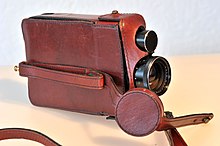Agfa Microflex
The Agfa Microflex was the smallest camera for the Super 8 system when it was launched in the summer of 1969 .
construction
Pocket cameras
Technical progress made it possible at the end of the 1960s to manufacture particularly compact drives in large series. This led to pocket cameras , a development that Agfa immediately supported, as the additional application of an "always-with-you camera" promised additional sales of film cassettes - after all, the basic idea of all Agfa cameras was to increase film sales. The Microflex then appeared as the most compact Super 8 camera on the market.
Model name
The name Microflex deviated completely from the Agfa tradition of using Movex to designate cine film cameras . The micro in the name indicates the importance that one expected from a pocket camera. And -flex should avoid any impression that it is a single camera with a separate viewfinder. In fact, the viewfinder showed the image captured by the taking lens.
design
The design came from Schlagheck Schultes Design , the studio that also designed the Agfa photo cameras. So you could recognize the Microflex as an Agfa camera at first glance.
The sensor trigger also contributed to this . Agfa had introduced this shutter shortly before to counteract the blurring of photo cameras. Naturally, this feature was of no use to a film camera, which is why the subsequent Agfa cine film cameras no longer had it. With its orange-red color, it simply showed the uninitiated where the camera was being started.
The Microflex was delivered in a box lined with orange-red velvet. An ever-ready case made of brown leather, as known from photo cameras, was available as an accessory.
technical features
The Microflex was operated with just two mignon cells , which did not allow overdrive, it always ran at 18 frames per second. Their fully automatic exposure control worked with a CdS cell. The weight of the camera was around 500 g compared to, for example, 1220 g for the Movexoom 2000 . The case measured 15.4 cm x 9.6 cm x 3.4 cm; so it was only slightly thicker than the Super 8 cassette used with its 23 mm.
Models
Microflex sensor / Microflex 100 sensor
In 1969, only one model of the Microflex appeared, which is why there was no need for a number in the model name. The Microflex Sensor cost 498 DM and had an Agfa Movaron lens with f / 1.9 and 10 mm to 25 mm focal length, whereby the zoom only worked manually. There was a window above the lens, the frame of which switched on the exposure control by turning it and behind which the CdS cell was located. The two button cells were located under the lens behind a knurled screw. A flashing light in the viewfinder indicated the end of the film. The device came from the Agfa Camerawerk in Munich and had a silver-colored housing with black leather. With the appearance of the Microflex 200 , the name changed to Microflex 100 without anything else changing.
Microflex 200 sensor
The Microflex 200 , presented in 1970, differed in its slightly extended focal length range; it had an Agfa Movaron f / 2.0 with a focal length of 9 mm to 30 mm. It also differed from the first Microflex with its exposure measurement, the CdS sensor of which was no longer located behind a separate window, but rather the brightness was determined by the taking lens (TTL measurement). The camera could be recognized by its black housing, a color that was popular with professional cameras in those days. The first models still had the button cells for the light meter, later the two mignon cells took over this task.
Microflex 300 sensor
The Microflex 300 with its Agfa Movaron , f / 1.9, offered a further extended focal length range ; 8 mm to 32 mm focal length, which could also be zoomed with a motor. The 300 also had the black case, it came from Japanese production and remained in the range until 1977.
equipment
With the Cine Agfalux M , Agfa offered a film light that could be placed on top of the camera with a special holder. She worked with a 600 W halogen lamp. In addition, there were two close-up lenses, one for the range between 1 m and 2 m, another for a distance of up to 47.5 cm, which was particularly intended for creating film titles.
Web links
- Agfa Microflex sensor. In: The Kurt Tauber Collection ( www.kameramuseum.de ). Retrieved January 7, 2011 .


